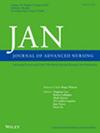Tensive Adaption: A Grounded Theory on the Process of Nurses' Dealing With Workplace Violence
IF 3.4
3区 医学
Q1 NURSING
引用次数: 0
Abstract
AimTo explore the process of how nurses experience and deal with workplace violence based on nurses' perceptions and experiences in Iran.MethodsAn exploratory qualitative study was conducted using grounded theory approach. Participants included 17 nurses working in 4 hospitals in 2 urban areas in Iran with at least 1 year of clinical experience in emergency departments and intensive care units. Data were collected through in‐depth, semi‐structured individual interviews conducted between August 2024 and March 2025. The constant comparative analysis approach was used for data analysis. This research method was carried out in five stages: open coding to identify concepts; development of concepts in terms of their characteristics and dimensions; contextual analysis; integration of the process to data analysis; and final category integration.FindingsThe main concern of participants in dealing with workplace violence was a ‘multidimensional security threat’. ‘Perpetrator response to nursing care’ (at the individual level) and ‘organisational inefficiency’ (at the organisational level) provided the context for this threat. A general theme entitled ‘tensive adaptation’ was the core category in this research and included four main categories: ‘tolerant reactions’, ‘seeking help’, ‘passive reactions’ and ‘hostile reactions’. ‘Organisational damage’, ‘nurse damage’ and ‘patient damage’ were the outcomes.ConclusionThe theoretical model of ‘tensive adaptation’ provides a new perspective on ‘what’ and ‘how’ nurses experience and manage workplace violence. Effective strategies for managing violence such as effective communication, empathy, providing appropriate care, anger management, self‐care, effective teamwork and requesting support can be considered by nursing administrators and incorporated into training programmes for nurses and nursing students. The adverse consequences of nurses' exposure to workplace violence should receive greater attention, as the entire healthcare system is affected by this exposure.Implications for the Profession and/or Patient Care紧张适应:护士应对职场暴力过程的扎根理论
目的根据伊朗护士的认知和经验,探讨护士如何经历和处理工作场所暴力的过程。方法采用扎根理论方法进行探索性质的研究。参与者包括在伊朗2个城市地区4家医院工作的17名护士,他们在急诊科和重症监护室至少有1年的临床经验。数据通过深度、半结构化的个人访谈收集,访谈时间为2024年8月至2025年3月。数据分析采用恒常比较分析法。该研究方法分五个阶段进行:开放编码识别概念;概念的特征和维度的发展;语境分析;流程与数据分析的整合;最后是类别整合。调查结果参与者在处理工作场所暴力时最关心的是“多方面的安全威胁”。“肇事者对护理的反应”(在个人层面)和“组织效率低下”(在组织层面)为这种威胁提供了背景。一个名为“紧张适应”的主题是本研究的核心类别,包括四个主要类别:“宽容反应”、“寻求帮助”、“被动反应”和“敌对反应”。结果是“组织损害”、“护士损害”和“患者损害”。结论“紧张适应”理论模型为护士“什么”和“如何”经历和管理工作场所暴力提供了新的视角。护理管理人员可以考虑有效的暴力管理策略,如有效的沟通、同理心、提供适当的护理、愤怒管理、自我护理、有效的团队合作和请求支持,并将其纳入护士和护理学生的培训计划。护士暴露于工作场所暴力的不良后果应该得到更多的关注,因为整个医疗保健系统都受到这种暴露的影响。对职业和/或病人护理的影响工作场所暴力导致身体和心理问题,降低工作满意度,降低绩效,对个人和家庭生活产生负面影响,降低病人护理质量。参与者在处理工作场所暴力时主要关注的是“多维安全威胁”。这一概念包括三个特点:“心理健康威胁”、“身体健康威胁”和“职业地位威胁”。“施暴者对护理的反应”(个人层面)和“组织效率低下”(组织层面)是使护士暴露于工作场所暴力的环境条件。在“紧张适应”中,护士试图通过“宽容反应”、“寻求帮助”、“被动反应”和“敌对反应”等策略来应对工作场所暴力。“组织损害”、“护士损害”和“病人损害”是护士暴露于工作场所暴力的后果。报告方法采用定性研究综合报告标准(COREQ)报告本研究。患者或公众的贡献本研究的设计、实施或报告中没有患者或公众的参与。
本文章由计算机程序翻译,如有差异,请以英文原文为准。
求助全文
约1分钟内获得全文
求助全文
来源期刊
CiteScore
6.40
自引率
7.90%
发文量
369
审稿时长
3 months
期刊介绍:
The Journal of Advanced Nursing (JAN) contributes to the advancement of evidence-based nursing, midwifery and healthcare by disseminating high quality research and scholarship of contemporary relevance and with potential to advance knowledge for practice, education, management or policy.
All JAN papers are required to have a sound scientific, evidential, theoretical or philosophical base and to be critical, questioning and scholarly in approach. As an international journal, JAN promotes diversity of research and scholarship in terms of culture, paradigm and healthcare context. For JAN’s worldwide readership, authors are expected to make clear the wider international relevance of their work and to demonstrate sensitivity to cultural considerations and differences.

 求助内容:
求助内容: 应助结果提醒方式:
应助结果提醒方式:


